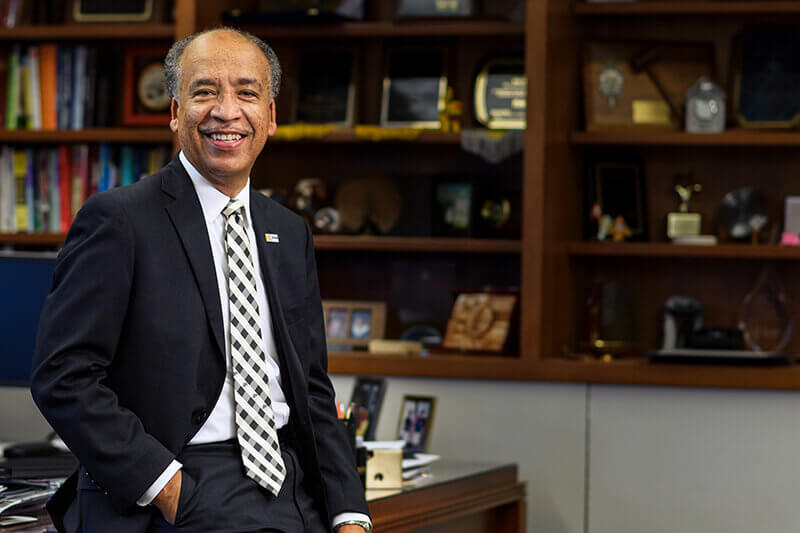September 25, 2019
What will the next 150 years bring for the College of Veterinary Medicine?
 Willie Reed, dean of the College of Veterinary Medicine. (Purdue University photo/Rebecca Wilcox)
Download image
Willie Reed, dean of the College of Veterinary Medicine. (Purdue University photo/Rebecca Wilcox)
Download image
The sesquicentennial celebration marks a time for Purdue to renew its commitment to growth, discovery and innovation. What giant leaps will the next 150 years bring as Purdue continues its drive to meet the world's future challenges? In this monthly Purdue Today series, Purdue's deans will share their thoughts on the future of their college over the next 150 years. The series continues with Willie Reed, dean of the College of Veterinary Medicine.
What will the next 150 years bring for the College of Veterinary Medicine?
Think back with me to 1869 and picture yourself in a farm field with some cattle in the distance, a working farm dog by your feet, and a barn cat nearby. Your veterinarian pulls up in a horse-drawn buggy, gets out and pats the dog before heading into the barn to get to work treating a sick cow.
Who in that picture would have predicted that today, most veterinary practices would be focused on small animals, and that dogs and cats would share their owners' beds, make regular visits to the veterinarian, get MRI and CT scans, and receive complex treatments for all manner of diseases, including cancer, kidney failure, cataracts and heart disease? And who would have anticipated that large animal veterinarians would work as consultants promoting the health of entire herds? And who would have guessed that veterinary scientists would conduct comparative medical research advancing both animal and human health, or that government veterinarians would be on the front lines protecting food safety and public health?
Given that amount of change, can you imagine what veterinary medicine will be like 150 years from now? Think of surgery performed by robots and personalized medicine precisely fine-tuned to a particular animal’s condition with minimal side effects. Imagine routine treatments for diseases that today are incurable, thanks to veterinarians’ contributions to medical discovery.
Veterinary medical support for animal agriculture likely will be revolutionized as well, with the development of highly sophisticated approaches to ensuring healthy livestock, obsoleting the risks of foodborne illnesses and increasing the feasibility of expanded food production. Consider that current forecasts predict that more animal protein will be needed in just the next 20 years to feed 9 billion people.
Veterinary medicine also will become much more focused on One Health, which is destined to become a household term defining veterinary medicine’s role in addressing the needs of society in the areas of food security, biomedical research and ecosystem health. One hundred fifty years from now, veterinarians and veterinary nurses will be among the first to be consulted and involved in advanced medical research, efforts to combat disease outbreaks, and responses to biosecurity threats and environmental hazards.
All of this will influence veterinary education, both in terms of the breadth of subject matter students will have to master and the methodologies employed in the learning process. Just as laptops replaced pen and paper, artificial intelligence and robotic equipment will replace today’s basic hands-on procedures. The College of Veterinary Medicine will educate veterinarians and veterinary nurses for positions described by job titles unknown today, to administer treatments we can’t imagine to achieve mind-boggling advances in animal and human health. Certainly entirely new fields of specialization will be taught and new areas of medicine will be researched as the College of Veterinary Medicine educates new generations of One Health veterinarians.
But not everything will change. The dynamic of the human-animal bond, cared for by veterinary medical professionals, will function in the distant future as it has for centuries – expressed by the loving gaze of a dog, the soft purring of cat, or the graceful yet powerful movements of a horse carrying its rider across the pasture. Some things are timeless … and for good reason.

